Control tube on a gas pipeline: purpose + installation rules on the case
There are many advantages to laying gas pipelines underground.They do not spoil the exterior of city buildings and the suburban landscape, do not interfere with the movement of transport, and do not force existing buildings to be displaced. But they have a significant drawback - the difficulty of monitoring both the pipe itself and the medium moving through it.
We will tell you how the control tube on the gas pipeline helps to monitor the condition of the system. Let us introduce you to the design features of this device. Let's look at the location options and installation rules.
From the article we presented, you will learn where and in what sequence control tubes are installed on the gas pipeline system. Familiarize yourself with the features of attaching them to cases and semicircular casings. You will understand how necessary it is to monitor the technical condition of an underground pipeline.
The content of the article:
The purpose of monitoring the condition of an underground gas pipeline
Gas pipelines laid in trenches require regular inspection no less than ground routes. Of course, they are not at risk of purely mechanical damage, as happens with openly arranged communications. However, gas workers have no less reasons to worry about their condition.
If the pipe transporting blue fuel is immersed in the ground:
- It is difficult to monitor the mechanical condition of a gas pipeline, but its walls are affected by soil pressure, the weight of structures and pedestrians, as well as passing vehicles if the pipeline passes under a highway or railway line.
- It is impossible to detect corrosion in a timely manner. It is caused by aggressive groundwater, the soil itself, which contains active components.The loss of original technical characteristics is facilitated by technical fluids penetrating to the depth of the route.
- It is difficult to determine the loss of tightness resulting from a violation of the integrity of the pipe or welded joint. The cause of loss of tightness is usually oxidation and rusting of metal pipelines, simple wear of polymer structures, or violation of assembly technology.
Despite the fact that the laying of gas pipelines in trenches involves the complete replacement of aggressive soil with soil with neutral properties, and installation in places where technical liquids may spill is completely prohibited, without special devices they cannot be considered completely protected from chemical aggression.
As a result of loss of tightness, gas leaks, which, as befits all gaseous substances, rushes upward.Penetrating through the pores in the soil, the gaseous toxic substance comes to the surface and creates negative zones for all living things above the gas pipeline.
A gas leak can easily cause a serious disaster if the blue fuel that leaves the pipe “finds” some kind of cavity in the ground for accumulation. When heated, for example, by simple exposure to sunlight in the hot summer, an explosion of the accumulated gaseous fuel is almost inevitable.
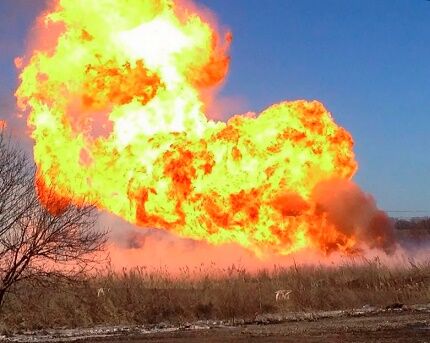
In addition, a gas leak entails considerable financial losses for the gas production and gas transportation organization. Moreover, disagreements may arise between them, which is not even worth going to court if a control tube for monitoring was not installed on the gas pipeline casing.
What does a gas pipeline need a case for?
In the installation of underground gas communications, steel or polyethylene gas pipes, capable of withstanding the pressure of the medium passing through them. Their strength characteristics are designed for loads created by soil thicknesses up to 2.0-2.2 m. However, standard rolled pipes are not designed for possible transport loads from above, i.e. over the gas main.
It is also not taken into account that it is undesirable for the pipelines through which gas moves to the consumer to pass under other communication lines. There are also geological and hydrogeological restrictions, according to which the gas pipeline has to be laid above the established standards.
If it is impossible to find a laying route that does not cross other engineering structures, in accordance with the requirements of SNiP 42-01-2002, it is necessary to ensure a safe vertical distance between pipelines. This is 0.2 or more meters, which as a result changes the depth of the gas pipeline.
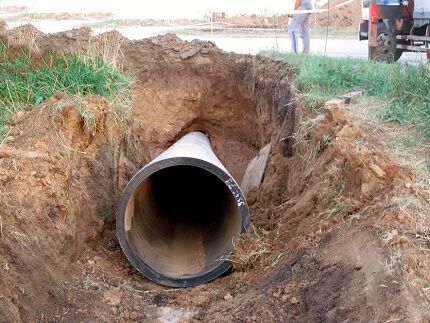
The laying depth of the gas pipe is also changed if rock formations or unstable groundwater levels interfere with laying it at the standard depth mark.
How to protect a gas pipeline if additional load on the line is inevitable? In all of these cases, cases are used, which are a rigid round or semicircular casing made of steel alloy, polyethylene or fiberglass. It is this that protects the path of blue fuel from possible damage.
Note that when installing gas pipeline protection, it is even more difficult to monitor the condition of the pipe laid in the casing. To facilitate the difficult work of linemen, mining industry employees and gas supply structures, a control tube is installed on the gas pipeline.
We list all the possible prerequisites for installing cases with control devices over gas pipelines:
- The location of the underground gas main is close to a residential building or public building.
- Laying a gas pipeline at shallow depths.
- Installation under transport routes: automobile, tram, railway tracks.
- The presence of a threaded connection or weld on electric-welded metal pipes and polyethylene analogues.
- "Intersection", i.e. passage 0.2 m above or below the heating network and other communication lines.
- Enter gas supply pipe to the house through a load-bearing wall and vertical intersection of floors.
- Construction of a control and measuring point with a protective carpet. They are installed along the entire route every 200 m within cities and other populated areas. In areas free of habitation, they are installed every 500 m.
All of the above options except for crossing the floors with a gas pipe, as well as arranging the entrance and underground line exit on the surface, a control tube is installed on one of the edges of the case.
Even in the case of installation over a problematic weld, it is permissible to use not cases as a base for attaching the tube, but a semicircular metal casing.
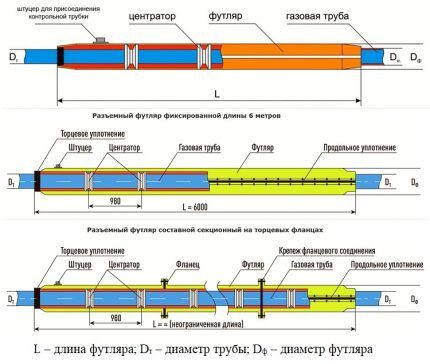
The control tube is placed in a place convenient for monitoring. Those. from the side from which the gas worker’s approach to carry out monitoring operations is possible, safe and does not require permits.
If two gas pipelines are laid in one trench, which is allowed by building regulations, then the location of the cases with the pipes connected to them should ensure tracking of both systems.

The cases are installed both on newly laid gas pipeline lines and on existing branches by piercing or pushing through the soil. They should extend beyond the boundaries of highways, highways, load-bearing walls and other structures by 2 m on both edges.
Control tube design
The minimum distance from the top of the case to the ground surface according to the standards is 0.8 m, the maximum is 3.0 m.In places where no transport load is planned, the minimum thickness of the soil above the case can be reduced to 0.6 m. The traversed soil thickness determines the height of the control tube, which should extend to the surface.
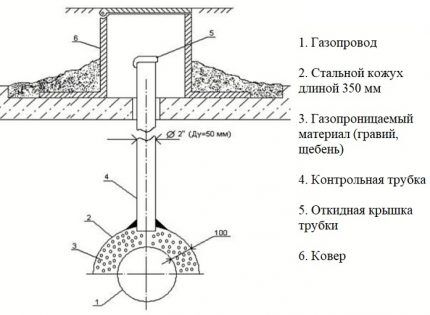
Structurally, this control device is literally a tube fixed at one end to a case or semicircular casing of the gas pipeline. The second is brought to the surface and is equipped with either a flapper lid or a coupling with a tightly screwed screw plug.
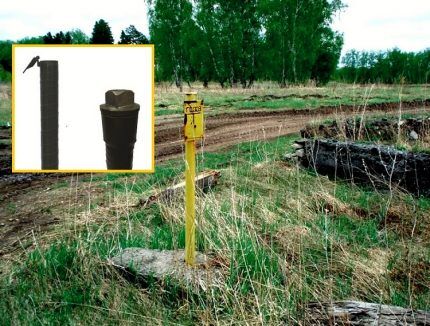
The diameter of the control tubes, which are installed on the casing or casing of the gas pipeline, according to technical standards is 32 and 57 mm. However, they can be produced in the sizes required by customers. In this case, to produce a series of tubes, a project is developed and specifications with quality requirements are approved.
Rules for installing and securing the tube
The control tube is attached to the case or semicircular casing of the gas pipeline in accordance with the material of the pipe and the protective system.
There are three main installation methods:
- Installation of the control tube along with a semicircular metal casing welded to its base.They are placed as an ordinary control point on the gas pipeline route without a casing after laying a steel or polyethylene pipe and partially filling it with sand up to 0.2 m.
- Attachment to a polyethylene case using a saddle and an adapter from polymer to steel. The hole for fixing the control tube is drilled before installing the case.
- Welding the base of the tube to the steel case. The welded assembly is arranged using a hole pre-drilled in the gas pipe.
If the tube is not welded directly to the gas pipeline, then there must be a layer of sand between its base and the pipe. The tube itself is wrapped in plastic film or coated with a waterproofing primer.
In new generation cases made of fiberglass, the control tube attachment point is installed during the manufacturing process. This solution greatly simplifies the installation process.The tube is screwed before installation and the joint is sealed, after which the pit with the gas pipeline is filled with soil.
The design and arrangement of the top of the control tube is carried out in accordance with the type of surface through which it is discharged. If there is a hard covering (concrete slab, asphalt), a protective cap or carpet is placed over the top. If there is no hard covering, the tube is placed 0.5 m above the ground and smoothly bent 180º.
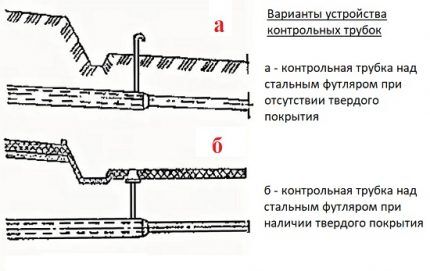
Through the control tube, the lineman, who is obliged to monitor the technical condition of the gas pipe and the density of the transported gas, inserts a gas analyzer hose or a pressure gauge sensor and takes instrument readings. The data collected by him is entered into the survey log.
Conclusions and useful video on the topic
The following video will introduce you to all types of structures and devices intended for servicing a gas pipeline and monitoring its technical condition:
Information about the nuances of laying and equipping gas pipelines will be useful to owners of suburban areas who want to connect their property to a centralized gas supply.
Of course, the information will be extremely useful for those who intend to organize an autonomous network with a gas tank and pipes laid from it. With the installation of a control tube, monitoring the condition of the underground system will become much easier.
Please leave comments in the block form located under the text of the article, ask questions, post photos on the topic.Tell us about your own experience in installing control devices to monitor the operation of a gas pipeline at your own site. Share useful information that may be useful to site visitors.



